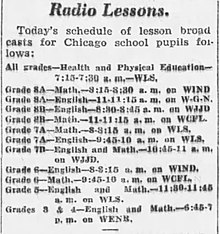Distance education program
In order to provide elementary school students with instruction during the indefinite school closure, superintendent of Chicago Public Schools William Johnson and assistant superintendent in charge of elementary schools Minnie Fallon developed a distance learning program that provided the students in grades three through eight with instruction via radio broadcasts. [3] [8] [4] The idea for such a program was first suggested by George H. Biggar of station WLS. [6] Distance learning instruction was, ultimately, broadcast for two weeks, beginning on September 13. Elementary schools reopened for in-person instruction on September 27. [2] [9]
Regarded to have been the first large scale experiment with "radio school", [2] Chicago's experiment with it attracted the interest of educators across the United States. [3] The idea of using radio to facilitate distance learning was considered innovative and untested. [3] Out-of-city newspapers even sent correspondents to Chicago to report on it, and newsreels were created that reported on Chicago's experiment in mass distance education by radio. [4]
Fallon cited a belief that children in the elementary school grades first and second required more individual attention are not adaptable to distance education as the reason that those grades were not provided with such instruction. [10] Johnson cited a lack of enough radio air time as the reason that high school students were not part of the program either. [10] Johnson recommended that high school students spend the period of the school closures reviewing their notebooks from their previous semester of school. [10] It was also believed that high school students would be mature enough to review their previous year's material on their own. [6] High schools would ultimately be closed for a shorter period than elementary schools, returning to in-person instruction on September 16, a day after the Chicago Board of Health determined that it was it safe for high schools to reopen but still unsafe for elementary schools to. [4]

Lessons were presented in 15-minute slots of airtime. [3] Airtime was donated by the radio stations WCFL, WENR, WGN, WIND, WJJD, and WLS. [3] The lessons were written by teachers and principals. [3] WLS built special studios in the headquarter building of the Chicago Board of Education for the broadcasts. [6] Lillian M. Tobin was put in charge of the curriculum. [11] Oversight was provided by "subject area committees" that were tasked with ensuring quality and continuity in the lessons. [3] Efforts were taken to make the broadcasts entertaining to students, in order to better engage them. For instance, explorer Carveth Wells was booked to speak during some of the broadcasts. [3] Each day’s instruction began at 7:15 am with the program for the day being read by August H. Pritzlaff, the head of Chicago Public Schools' physical education department. [10]
Lessons were scheduled in such as manner that different days of the week were dedicated to different subjects. Mondays, Wednesdays, and Fridays were dedicated to science and social studies, while Tuesdays, Thursdays, and Saturdays were dedicated to English studies and mathematics. [3] Broadcast schedules, as well as directions, questions, and assignments were published in the city's newspapers, [3] with six city newspapers cooperating. [12]
A helpline was established in order to allow parents to provide comment, as well as to help answer questions parents would have about the radio programs and the epidemic, with educational personnel manning the hotline. [3] [8] The helpline was staffed by sixteen teachers. [13]
Parents were encouraged to supplement the lessons by facilitating daily study periods with their children following the broadcasts. [3] In order to educate students who missed broadcasts, such as those who not have access to a radio or those who encountered poor reception, make-up work was created. [3]
Once they returned to in-person learning, students were tested on the material that had been covered by the radio broadcasts and newspaper publications. [8] The purpose of these tests was both to assess the effectiveness of the instruction, [14] as well as to decide what grade credit each student would receive for their work on the radio lessons. [12]